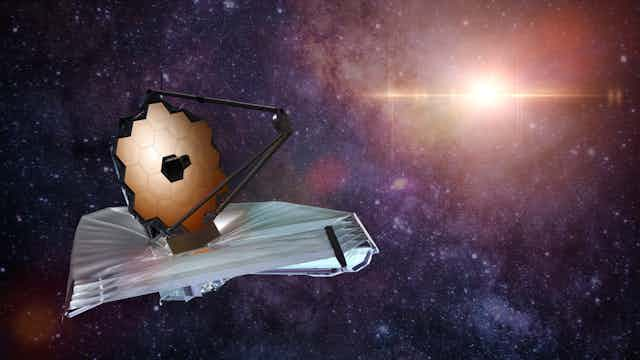The gigantic James Webb Space Telescope is undergoing its final tests ahead of the launch scheduled for late December. In this episode of The Conversation Weekly podcast, we speak to two astronomers about the telescope and the questions they hope it will answer about the beginning of the universe and the conditions on exoplanets orbiting faraway stars.
And we hear about new research into the tactics used by the food industry to boost sales of ultra-processed foods in middle-income countries.
With a mirror six and a half metres in diameter, a Sun shield the size of a tennis court and an instrument compartment bigger than a phone booth, the James Webb Space Telescope is enormous. The mission to get it into space has been nearly 25 years in the making at the cost of around US$10 billion.
After years of delays, and a few last minute technical hitches, the telescope is finally set to blast into space from Kourou in French Guiana on December 22.
Martin Barstow, professor of astrophysics and space science at the University of Leicester in the UK and chair of the Space Telescope Science Institute Council, which will run the operations centre for the James Webb Space Telescope, says the launch will be a nervous moment for astronomers. After the Hubble Space Telescope launched in 1990, a problem with its mirror meant the images it sent back were blurred, and Nasa had to send a team of astronauts to fix the problem. But James Webb is going out much further into space, to what’s called a Lagrange point about a million miles from Earth.
“We cannot go and repair this one, says Barstow. "It’s too far away. The most important thing for me is to see the telescope working. Those of us who are close to it, know what can go wrong. I don’t care what the first image is, I just want to see an image that’s in focus.”
Once the telescope is up and running, it will allow astronomers to peer back in time to look for the light from the earliest stars that formed soon after the big bang.
One question astronomers hope it will answer is how those first stars formed into galaxies. This is what intrigues Marcia Rieke, Regents professor of astronomy at the University of Arizona in the US and the principal investigator for one of the cameras onboard the telescope, the near-infrared camera.
“We have some clues that a range of sizes of galaxies or star clusters formed early on,” says Rieke, “but we don’t understand what that range of sizes is. Nor do we understand very well how those pieces come together to form bigger and bigger galaxies.”
The telescope will also be able to improve our understanding of exoplanets, planets in orbit around other stars. Barstow says the instruments on James Webb will allow astronomers to measure the atmospheric composition and temperature of these planets. “We might even be able to see evidence for the existence of structures in the atmosphere, such as clouds,” he says.
In our second story in this episode, we look at the market for ultra-processed foods such as soft drinks, cakes, snacks or frozen meals. Consumption of these types of foods and drinks is associated with higher risks of obesity, cardiovascular disease and type 2 diabetes. But they’re also big business for the food industry, and in recent decades companies have realised that the fastest-growing markets for these kinds of foods are in middle-income countries such as South Africa, Indonesia, China and Brazil.
Edwin Kwong, a research fellow at the University of Melbourne in Australia, explains his recent research into the tactics some of these companies are using to target consumers in these industrialising countries.
And Lutfhi Dzulfikar, an editor for The Conversation in Jakarta, Indonesia, gives us some recommended reading about the recent volcanic eruption on the island of Java.
This episode of The Conversation Weekly was produced by Mend Mariwany and Gemma Ware, with sound design by Eloise Stevens. Our theme music is by Neeta Sarl. You can find us on Twitter @TC_Audio, on Instagram at theconversationdotcom or via email. You can also sign up to The Conversation’s free daily email here.
You can listen to The Conversation Weekly via any of the apps listed above, download it directly via our RSS feed, or find out how else to listen here.

